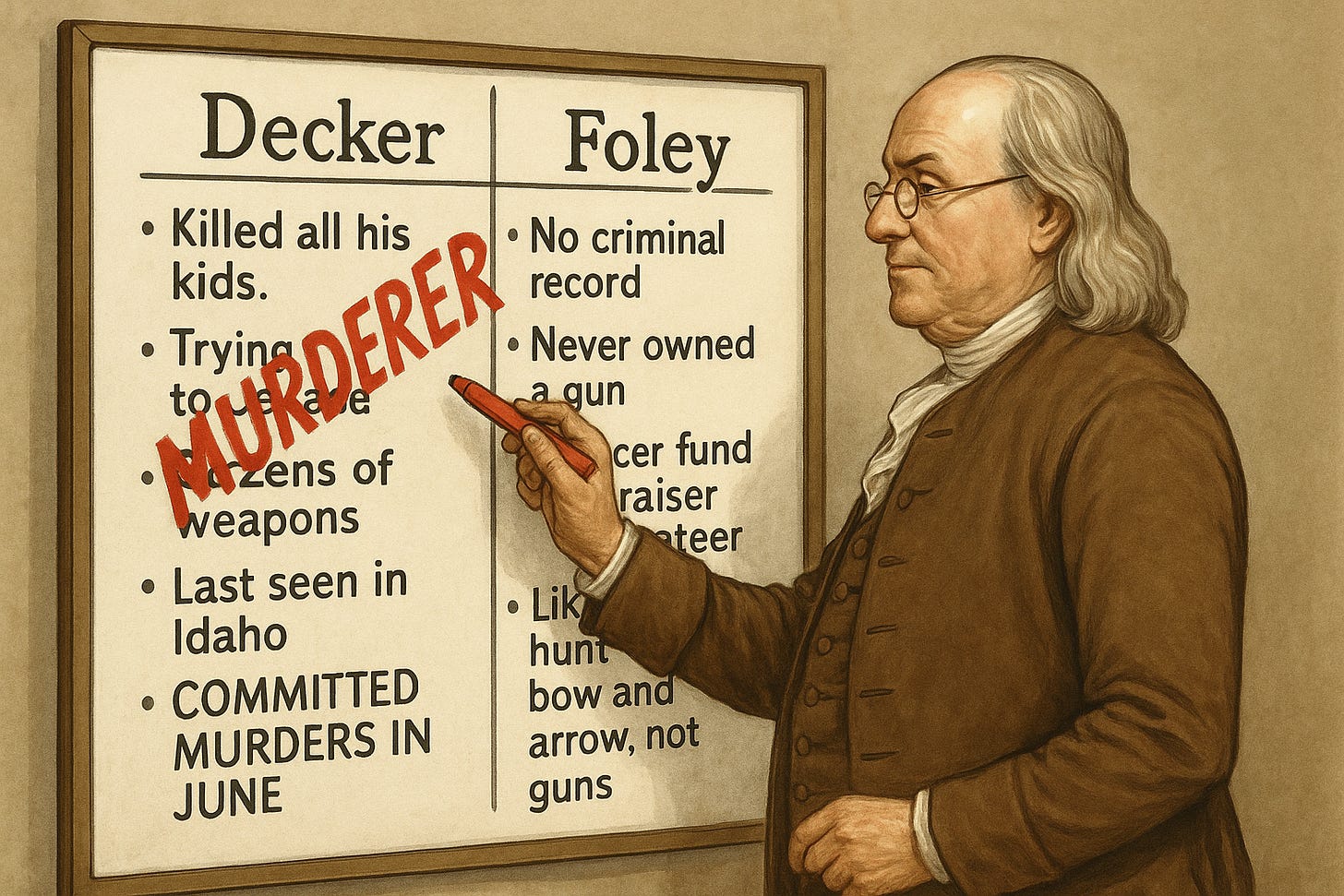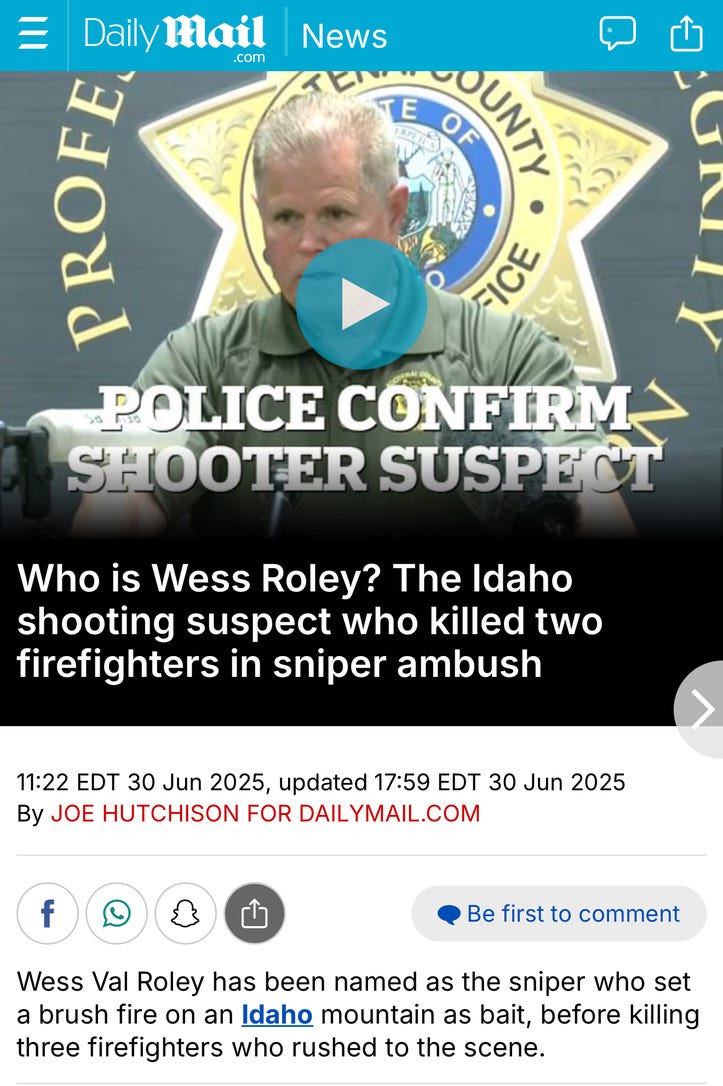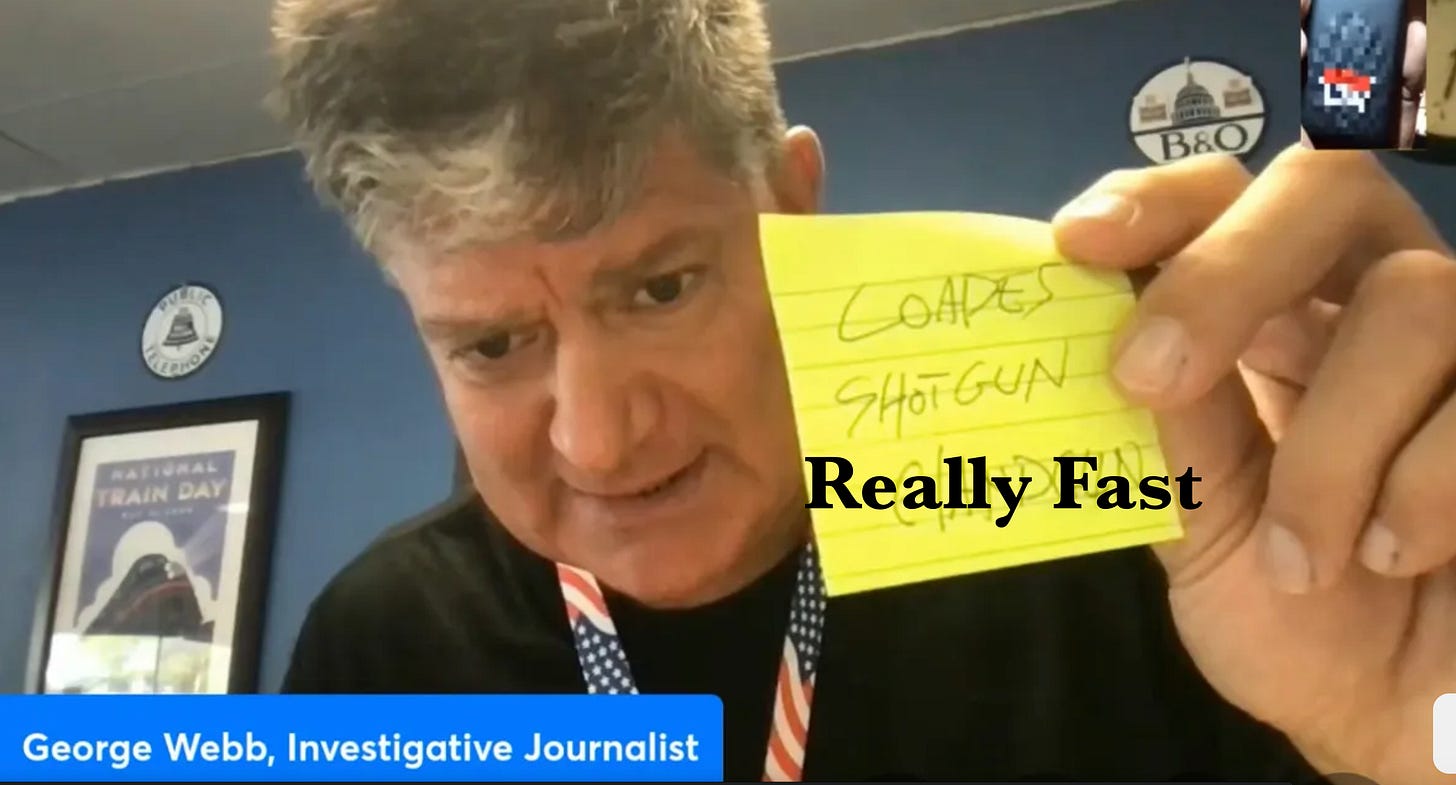Fake News Working Overtime For Idaho Shooter
Sheriff Ignores Serial Killers Who Strangled All His Children Lurking In Idaho Woods To Focus In One Twenty Year Old Suspect Who Has Never Committed A Crime Or Owned A Gun
Here is a summary of my livestream from today for those who don’t have the time to watch the entire broadcast.
Part 1 – Setting the Stakes
George Webb opens by blasting “fake-news chicken-feed” coverage of the Canfield Mountain shootings. He frames the episode as a split-screen mystery: on one side is Travis Decker, a 36-year-old former Army Special Forces soldier who, a month earlier, allegedly suffocated his three little girls, zip-tied their hands, and dumped their bodies off a Washington embankment before vanishing into the Idaho panhandle.
On the other side is 20-year-old Wess Cuchiara-Roley—no criminal record, lived quietly with a roommate in Sandpoint, drove an old van, loved archery, and had never even bought a firearm.
Wes Cuchiara Roley never committed a crime or bought a firearm.
When two veteran fire-service chiefs are shot dead and a third badly wounded during a wildfire response near Coeur d’Alene, Sheriff Bob Norris instantly fingers Cuchiara-Roley as the lone gunman. Webb’s question: no Amber-alert-style bulletin on Decker, the proven child-killer and trained woodsman “last seen in these very hills,” while the patsy narrative around an unarmed kid blooms overnight.
Part 2 – The Ben Franklin Balance Sheet
To disentangle facts from spin, Webb revives Ben Franklin’s “T-chart” decision method.
Column A: Decker. He has special-forces survival skills, a cache of weapons, extreme PTSD, and a motive—escape to Canada, broadcast in his own June 5 web posts. He was spotted near McCall and Priest River between 16 and 30 June, placing him squarely in the Coeur d’Alene corridor. Column B: Cuchiara-Roley. No police run-ins, no firearms purchases, no history of violence; his last roommate of six months never even saw a BB-gun.
Franklin’s ledger, Webb argues, makes Decker the obvious suspect: a desperate fugitive who has already proved capable of killing innocents. Yet official briefings mention none of this. Local reporters dutifully jot down “lone 20-year-old shooter” and hurry off to file, never asking how a kid with a pump-action shotgun supposedly pinned down 300 armored officers, a Black Hawk helicopter, infrared drones, and snipers for hours.
Part 3 – Decker’s Dark Trail
Webb re-traces Decker’s zig-zag flight from Wenatchee. On 4 June he murders his daughters; by 5 June he is Googling “relocate to Canada.” Between 16 and 30 June he is repeatedly sighted along the I-84/I-90 corridor: Sandpoint, Priest River, and the Canfield trailheads—classic exfil routes to remote border crossings. A U.S. Marshals fugitive task-force quietly shadows him; Webb sees their unmarked SUVs and radio chatter at the fire scene minutes after the first 911 call.
Decker’s Ranger training lets him live off-grid for months, and his psychological profile fits the “cornered commando” who starts diversionary burn-scorched-earth tactics. Webb posits that Decker needed a “wheel man” to reach Canada without triggering license-plate readers. Cuchiara-Roley, with a working van and a trusting nature, was ideal: befriend him, promise adventure, then remove him once the ride becomes inconvenient—standard Phoenix-Program tradecraft.
Part 4 – Portrait of Wess Cuchiara-Roley
Wess—nicknamed “Westifer” by his mom—grew up among North Idaho’s logging families. Photos show a soft-faced teen in a Megadeth T-shirt, hauling brush for his dad’s Priest River tree-service.
His stepfather, Tony Cuchiara, runs Arizona Archery and once served in the US State Department Diplomatic Security, a fact Webb flags only because mainstream outlets twist it into a sinister “paramilitary grooming” meme. Friends describe Wess as shy, bookish, obsessed with Tolkien and compound bows, not guns.
He leaves his Sandpoint rental in January, living out of his Ford van on back roads—common among seasonal loggers. No restraining orders, no knife threats, no juvenile record; those sensational claims appear after his death and are promptly contradicted by the sheriff’s own press-conference statement of “no criminal history.”
To Webb, the overnight smear campaign screams cover-story: dead men can’t sue for defamation, and a sullied patsy protects the real trigger-man.
Part 5 – Press-Conference Sleight of Hand
Sheriff Norris’s timeline mutates hourly. First briefing: “rapid-fire rifle volleys,” maybe “one, two, three, even four shooters.” By dawn it’s miraculously one kid with a five-round shotgun. The sheriff concedes his deputies “scooped up the body,” skipped ballistic mapping, took no DNA swabs, and literally bulldozed the primary van down a ravine—“scene contamination” that would flunk a rookie.
Yet he urges residents with hunting rifles to “take the shot” if they glimpse any threat. Webb plays clips of reporters nodding along instead of asking why a triple-child-murder fugitive isn’t topic #1. He likens the local media scrum to chickens pecking at feed: “Which pullet swallows the narrative first wins the byline.”
The Daily Mail incorrectly reported three firefighters had been killed instead of two, and the New York Post incorrectly printed eleven firefighters had been shot instead of the correct number of three.
When Associated Press later injects an invented “2013 knife arrest,” Webb races to county databases—nothing. CNN, MSNBC, King-5 Seattle all repeat the fiction. The sheriff does not correct them.
Part 6 – The Van, the Bridge, and the Missing License Plate
A linchpin detail: deputies and the two slain chiefs supposedly “rocked” Cuchiara-Roley’s parked van, then shoved it off a mountain track to block his escape.
Why risk daylight exposure under active fire when simply deflating tires would immobilize it? Where are the photographs, VIN, or plate numbers? Webb drives every trailhead; none show fresh skid scars.
Hours after the sheriff’s late-night presser, 911 reports a man thrown off the I-90 bridge—classic CIA “cookbook” method for stealing a vehicle: befriend, stop for a smoke, heave the passenger into the gorge, then phone in an anonymous “jumper” alert. Was that Decker acquiring new wheels while cops swarmed Canfield?
Again, no follow-up from the authorities. For Webb, the van mystery and the bridge death fit an orchestrated diversion: keep eyes on a dead 20-year-old while the real fugitive slips north under smoke cover.
Part 7 – Weapon-Sound Logic and Tactical Impossibilities
Fireground radio logs describe “burst fire, metallic cracks” ricocheting through the timber—signatures of a semi-automatic rifle, not the deep “boom” of a slug-loaded pump shotgun.
Veteran firefighters, hunters, and every police academy cadet can tell the difference. Yet the sheriff retrofits the narrative to a single shotgun under the victim’s torso (earlier briefings said “nearby”). Some outlets claim he also used a handgun; others mention buckshot. Webb notes that slugs and birdshot leave vastly different wound profiles—details still undisclosed.
Meanwhile, 300 officers in night-vision gear, drones, and a Black Hawk equipped with thermal optics allegedly can’t flank or suppress one lone, untrained shooter. Webb’s verdict: “operational theater” staged to justify lethal helicopter engagement—conveniently killing the patsy who could testify. The real marksman, experienced with rifles, escapes amid chaos, consistent with Decker’s profile.
Part 8 – Potential Motives: From Phoenix Program to Coeur d’Alene 2030
Why target fire chiefs? Webb’s researchers tie both victims to disputes over “controlled-burn” zoning under the Coeur d’Alene 2030 redevelopment plan—turning wooded slopes into gated lakeview estates.
https://www.cdaid.org/files/Fire/Documents/CDA_Vision_2030.pdf
Fire-service leaders who balk at intentional burns become obstacles. Contract a deniable asset—say, a war-scarred assassin needing exfil—and provide cover via a patsy and a wildfire. Phoenix-Program playbooks from Vietnam taught exactly that: start a blaze, eliminate local leaders, blame an expendable youth, then let higher-value operatives vanish.
Decker, with Ranger stealth and an alleged CIA-linked handler network (rumored diplomatic-security connections), fits the bill. His child-murders may have been a forced “burn-notice”—blood leverage ensuring lifetime obedience or silencing witnesses. Webb stops short of claiming certainty, but the motive matrix again leans Decker, not Wess.
Part 9 – Media Alchemy and Narrative Control
Webb dissects the information-warfare cycle: county PIO issues a brief; national wires copy-paste; cable hosts embellish; factoids mutate into “truth.” Within 24 hours, Cuchiara-Roley morphs from anonymous hiker to knife-wielding extremist, to trans cultist, to Aryan-nation biker, depending on outlet bias.
Getting the story right is easier when you are actually there, talking to witnesses and not guessing from afar.
Simultaneously, Decker’s name vanishes from feeds. Webb cites parallels: Long Island Serial-Killer misdirection, Las Vegas shooting, DC-sniper Lee Malvo grooming. In each, corporate media amplified convenient culprits while deeper contractor networks evaded scrutiny.
DC sniper Lee Malvo was groomed as a sniper by an older mentor.
Sheriff Norris’s Israeli-trained fusion-center pedigree, Webb warns, merges local policing with intelligence-style perception management: release just enough data to steer headlines, withhold the rest in the name of “ongoing investigation,” and let time bury inconvenient leads.
Part 10 – Webb’s Call to the Citizen Jury
Webb closes with missionary zeal: “Truth is a lion—just lift the cage.” He exhorts viewers to file FOIAs, map trail cameras, photograph license plates, archive police-scanner audio, and resist smear bait. “Get your cracker-jack magnifying glass,” he says, invoking sunlight as disinfectant.
Whether Decker is a CIA cut-out, a Mossad proxy, or merely a deranged deserter, Webb insists the public deserves forensic transparency: autopsy results, ballistic trajectories, chain-of-custody logs, and the missing van’s whereabouts. Until then, the Ben Franklin balance sheet stands: a desperate, triple-child-killer with military training, a graduate of the School of the Assassins, remains unaccounted for, while an unarmed 20-year-old is posthumously tried in the court of corporate opinion.
Webb pledges to stay on scene, “even if I lose every subscriber,” because he argues that only relentless citizen journalism can keep sheriffs, networks, and clandestine operators honest when lives—and the narrative—burn.



























I have followed and communicated with George Webb since the first week in October of 2016. Those of us who have followed from the start recognize certain words and phrases that jump off the page, such as Israeli trained , fusion centers, etc. We learned about these things eight and nine years ago, such as Andy McCabe, entrapment, and the Portland attempted false flag Christmas tree attack. It appears likely that the Sheriff and his cohort are following the assigned script.
Thanks GW and team for staying with this.
Why are they going to such trouble to protect Decker? Is he trained for something really big? And can’t be replaced in the needed time frame? Like July 4?